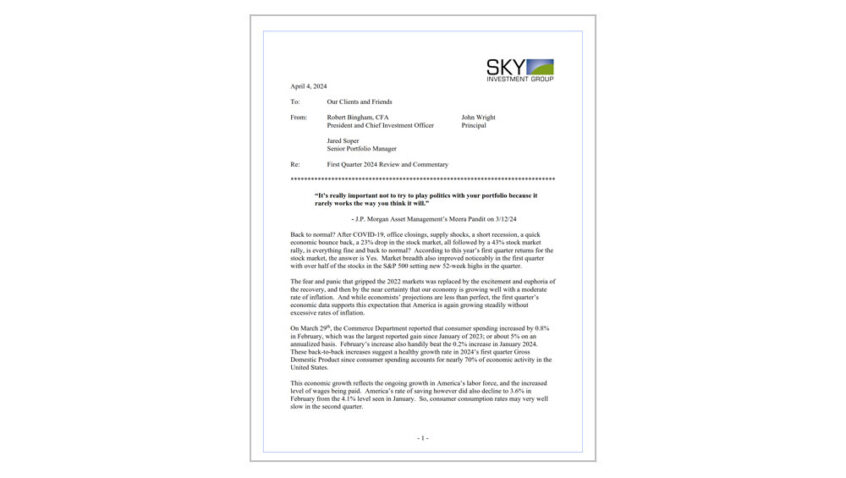View PDF Version of Newsletter
April 4, 2024
Robert Bingham, CFA, President and Chief Investment Officer
John Wright, Principal
Jared Soper, Senior Portfolio Manager
“It’s really important not to try to play politics with your portfolio because it rarely works the way you think it will.”
– J.P. Morgan Asset Management’s Meera Pandit on 3/12/24
Back to normal? After COVID-19, office closings, supply shocks, a short recession, a quick economic bounce back, a 23% drop in the stock market, all followed by a 43% stock market rally, is everything fine and back to normal? According to this year’s first quarter returns for the stock market, the answer is Yes. Market breadth also improved noticeably in the first quarter with over half of the stocks in the S&P 500 setting new 52-week highs in the quarter.
The fear and panic that gripped the 2022 markets was replaced by the excitement and euphoria of the recovery, and then by the near certainty that our economy is growing well with a moderate rate of inflation. And while economists’ projections are less than perfect, the first quarter’s economic data supports this expectation that America is again growing steadily without excessive rates of inflation.
On March 29th, the Commerce Department reported that consumer spending increased by 0.8% in February, which was the largest reported gain since January of 2023; or about 5% on an annualized basis. February’s increase also handily beat the 0.2% increase in January 2024. These back-to-back increases suggest a healthy growth rate in 2024’s first quarter Gross Domestic Product since consumer spending accounts for nearly 70% of economic activity in the United States.
This economic growth reflects the ongoing growth in America’s labor force, and the increased level of wages being paid. America’s rate of saving however did also decline to 3.6% in February from the 4.1% level seen in January. So, consumer consumption rates may very well slow in the second quarter.
Importantly, the Commerce Department’s inflation data also released on March 29th read favorably as well. Price increases in February rose less than expected with costs of household furnishings, manufactured goods, equipment, hotels, restaurants, and health care being well contained. Energy costs, housing, utilities, clothing, insurance and financial service costs all did go higher however. Yet overall, the Core Personal Consumption Expenditures Price Index increased 2.8% in February on an annualized basis versus the 2.9% rate seen in January. The Personal Consumption Expenditures Price Index increased on a 12-month basis by 2.5% through February.
Inflation rates, while improved, remain higher than the Federal Reserve would like to see. However, current rates of inflation are 50% lower than what we experienced in 2022. Yet, the scars from those 2022 increases can still be felt.
This data, amongst numerous other economic releases, will be tracked closely over the next few months by the Federal Reserve, market analysts and investors. Such data will determine what happens next to interest rates. Last December, bond investors anticipated that the Federal Reserve would cut interest rates by 25 basis points six times during 2024. Yet last December, the Federal Reserve had only projected three 25 basis point cuts in 2024.
These conflicting expectations coalesced around the Federal Reserve’s three rate scenario as 2024’s first quarter ended. First quarter economic growth also proved more robust than many anticipated as a 1% expected growth rate in GDP for the first quarter has been upgraded to 2% by many economists. Projections are always subject to change of course, but importantly last December’s recessionary concerns have abated materially given this year’s healthy level of consumer spending.
However, these better-than-expected growth trends may reduce the Federal Reserve’s inclination to cut interest rates. In fact, on March 27th, Federal Reserve Governor Christoper Waller stated, “In my view, it is appropriate to reduce the overall number of rate cuts or push them further into the future in response to recent data.”
This debate on when and how extensive might be any interest rate cuts will increasingly capture financial headlines. And such debates may reduce investors’ interest in buying stocks in the weeks or months ahead. Certainly, early April’s market sell-off reflected some of these concerns as the federal funds futures markets reduced expectations for a June interest rate cut to 55% from 70% in the middle of March. April and May’s corporate earnings releases will also help shape the markets’ movements.
And as we’ve said before, market corrections are a good thing. Markets never go in a straight line and opinions are never universal. Corrections allow investors to buy good assets on sale and/or at a discount. Traders take profits, and markets do often go sideways. New data and information are always being absorbed.
Interestingly enough, analysis from Bespoke Investment Group suggests that after two back-to-back quarters of 10% gains in the stock market, stocks decline by about 1% in the following month. But in the following two, three, six and twelve month periods, the S&P 500 Index has historically traded higher, or up about 12.3% one year later.
More importantly as the first quarter ended, corporate earnings for the S&P 500 companies were still expected to grow steadily over both 2024 and 2025. And cash flow per share for these companies was expected to grow by double digits in both years. Of course, these expectations will be shaped by first quarter earnings results; but as April began, fundamental trends looked quite good. Corporate fundamentals just may be growing into the stock market’s first quarter price action.
Risks do however remain ahead. Commercial real estate markets remain soft as measured by both the commercial mortgage-backed securities (CMBS) market and the RCA CPPI National All-Property Index. Depending on the type of property and region of the country, some property values have fallen by more than 40% from peak valuations in 2022.
In 2023, $541 billion of commercial real estate debt matured according to Trepp, the data analytics firm. And over $2 trillion of commercial real estate debt is expected to mature in these next three years. So far, borrowers have been able to renegotiate or extend terms. But according to CRED iQ, another real estate data provider, only 26% of 2023’s maturing $35.8 billion office CMBS loans were fully paid off last year. And Fitch Ratings projects that 4.5% of the CMBS loans will become delinquent in 2024, up from 2023’s 2.3% delinquency rate. Fitch also projects this delinquency rate to increase to 4.9% in 2025.
Meanwhile, the private equity community has raised over $240 billion to invest in distressed real estate according to Preqin, the alternative funds data tracking provider. Perhaps this sector’s weakness will be much absorbed by newly-allocated risk capital. Lower interest rates would clearly benefit America’s commercial real estate sector.
But if inflation doesn’t fall further, or energy prices go higher, or the economy grows more strongly, the Federal Reserve may choose to maintain their “higher for longer” interest rate policy. Government debt financing will also help keep interest rates higher. So, time will tell what policy shifts prevail and how markets react.
Do call us with any questions or let us know if you would like to meet any time soon.
These summary/prices/quotes/statistics contained herein have been obtained from sources believed to be reliable but are not necessarily complete and cannot be guaranteed. Errors and omissions excepted.

